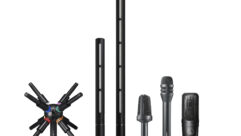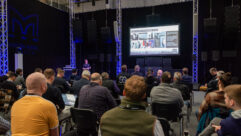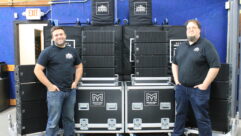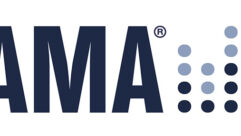The Best in Classroom Audio-Visual Storms SMUA natural disaster caused SMU to move a little more quickly in implementing its new distance learning systems.
May 20, 1996 12:00 PM,
David Keene
The university environment, with its wealth of talent and research resources, is often where the newest technical innovations first take root. However, at the Southern Methodist University Cox School of Business this past spring, it took more than academic reflection to prompt the decision to upgrade the school’s audiovisual facilities. On the night of May 5, 1995, a record-breaking rain and hailstorm swept across Dallas, destroying millions of dollars worth of property. A flash flood swept through the bottom floor of the business school, leaving several classrooms and teaching theaters submerged. With the spring semester almost over, the staff and faculty improvised for the remaining week of final exams. At the onset of the summer term, the administration decided to totally revamp and upgrade the school’s classroom audio-visual and distance-learning systems with the help of Bauer Audio Visual of Dallas.
“In a way, the flood was for the school a blessing in disguise,” said Tom Barry, former associate dean for academic affairs at the Edwin L. Cox School of Business and now vice president for academic affairs at SMU. “It prompted us to undertake in one fell swoop what would have undoubtedly been done piecemeal had the flood not wreaked so much damage in one night.”
Over spring break 1995, just a month before the flood, Bauer Audio Visual had already completed installation of audio-visual systems in six of the SMU business school classrooms; luckily these rooms were spared damage by the flood. Bauer Audio Visual was contracted to upgrade an additional eight rooms damaged in the flood, including Georges Auditorium.
State-of-the-art videoEach pit-style classroom (excluding Georges) is outfitted with a Sony VPH 1252Q data projector suspended from the ceiling with a Monger mount, a Stewart Filmscreen front-projection screen, a single Sound-sphere loudspeaker and a custom-designed lectern housing the computer, audio, video and control systems. Each lectern contains a Gateway 2000 P4066 computer, a Biamp Precedence CMA 30 W mixer-amplifier with eight inputs and a Sony SVO 1450 professional videocassette player. An AMX Axcent 2 system with an AMX 32-button, custom-designed control provides easy push-button control of the entire system. An Extron 109 Plus SVGA interface provides access to the Gateway computer. External inputs for Mac, VGA and audio run directly to an Extron 105 interface so that alternate sources can be sent to location B on the Sony video projector. In addition, all of the classrooms in the Cox School are wired with coaxial cable for cable television and analog phone lines.
With the Georges Auditorium, which is on the bottom floor of the building and was destroyed by the flood, a diverse group of contractors went to work over the summer to ready the room for the incoming MBA class arriving August 24. The room was gutted and redesigned from the ground up, with Bauer Audio Visual providing design and installation of the sound and video systems. With a seating capacity of 156, the room offers the business school community its best facility, and the decision was made early on to install the best available audio-visual equipment. The new auditorium now provides students and professors truly state-of-the-art video, Internet and distance-learning capabilities.
Essential to the design of the new auditorium was the hardwiring of each of the 156 desks in the room for ac with computer network connections to follow so that each student in the classroom will be on-line when the need arises. Despite a certain professorial fear that students in the back row would be Net-surfing through the entire lectures, student interaction with files through network connections was one of the goals of the room redesign.
Designing for distance learningKey to the auditorium’s projection system is a Sony VPH 1292Q video-data projector, set up in a rear-projection format behind a 99×129 (2.74 m x 3 m) Draper Cineplex acrylic rear-projection screen. This projector, one of the latest and most advanced from Sony, offers a maximum resolution of 2,000×1,600 pixels, a horizontal scan rate of up to 135 kHz, an RGB bandwidth of 120 MHz and three 9 inch (229 mm) electromagnetic focusing CRTs.
The sound system in Georges Auditorium consists of Crown amps (part of the IQ system). The Crown amps each have a pit module to keep them from being overdriven and to put them to sleep automatically if they’re not being used _ an energy-saving feature that will pay for the amp with reduced power consumption in the space of about a year. Equalization is provided by digitally controlled Biamp 282M EQs. The M is for memory: The units feature four different memory presets. The signal pumps out to three Electro-Voice PI Matrix loudspeakers, each 12×2, which were custom-configured with different horn and mid-bass drivers. These loudspeakers are part of Electro-Voice’s Permanent Install (PI) series of custom-configured loudspeakers that allow the installer to choose four or five drivers and four or five cones. The systems installer tells Electro-Voice such details as how to configure the horns and drivers, what kind of wood to use for the enclosure and whether the installation requires hanging points.
At the Georges Auditorium, two loudspeakers are cut into the wall on either side of the screen, with a third above the lectern for vocal reinforcement. The lectern has a jack on top to accept a gooseneck, and a Shure Sound Contractor series wireless lavaliere is built-in. If instructors don’t want a big gooseneck sticking out of the podium, they can put in a Crown PCC 130 into that same jack because the jack automatically switches for XLR or 1/4-inch.
Bauer custom designed the podium, which houses a computer, a Sony SV-1550 professional stereo VCR, a touch-panel control system and a Sony Vid-P 100 document camera _ one of the room’s new distance learning tools. The document camera sits in a large compartment, which slides into the lectern and is out of sight when it isn’t used. The camera is used in the same manner as a standard overhead projector, but with one important difference: The image captured on the easel of the unit is not projected onto the screen with a lens and bulb system. Instead, it is captured by a built-in video camera with auto-focus and zoom capabilities and then sent to the video projector. The idea is that in addition to functioning as a standard overhead projector within the classroom the image captured by the video unit can be transferred not only to the screen in Georges Auditorium but to any screen in any classroom, or on any monitor, anywhere in the world.
Another teaching and distance learning tool is the Softboard from Microfield Graphics. Also called a whiteboard, it is a large board that looks and functions like an ordinary whiteboard, but it does much more. As the document camera does with images, the Softboard converts the decidedly analog handwriting of the instructor into digital information. Its porcelain surface has a pair of laser scanners on the top that create X and Y coordinates for whatever is drawn on it. Different colored markers show up as different colors on the computer projection screen because each colored marker or eraser has a bar code read by the scanner. Again, who sees the writing depends on where you want the information to be read _ in the back row of the room or in a classroom in Singapore.
The Windows-based software that comes with the Softboard allows you to store as many pages as you choose to create, project the pages onto the screen, store and load the pages into any other Windows file or transmit the pages to any other remote location for live or stored presentation. Special software allows the instructor to create new pages, replay previously recorded pages or send pages to a system printer right from the board. Instead of spending time copying down what the instructor is writing, the students can stay more focused during class, can carefully follow the lecture (the material written on the Softboard is projected onto the screen) and then pick up the notes after class at the system printer.
John Criswell, director of SMU’s business information center and a member of the university’s distance-learning committee, pointed out the importance of these new educational tools. “This equipment is essential to distance learning because we can capture, with both the Softboard and the document camera, all of the presentation, just as a student or professor in the room experiences it, and we can send the entire presentation to any other site, anywhere in the world. If we have a class of 150 in here, and four other classes in other cities or countries, we can transmit to any of those sights instantaneously.
“SMU Cox School of Business ranks within the top 40 for the full-time MBA program and within the top 20 for our executive MBA program, so we will do whatever it takes to maintain and improve those ratings. We believe expanding the boundaries of SMU beyond the immediate Dallas area is something inevitable, given both the introduction of new technologies into the academic environment and the corollary growth and use of these new technologies in the business world.”
Taking it to the teachersHow is the faculty adapting to these new technologies? Barry has been pleased with the faculty response. “Several years ago, when the new technologies were being introduced, some professors resisted because they were not familiar or comfortable with them. Others resisted because they felt it was not proper to use them too much in the classroom — that classroom time was best devoted to critical and analytical activities that computer and A-V tools didn’t necessarily address,” Barry said. “But with these new systems Bauer installed, many faculty members have been very eager to learn to use them. They seem enamored of the new systems. Access to these new tools means professors can present graphics in the classroom more easily. It’s just amazing how quickly and efficiently a professor can present information, data or graphics and thereby have more time to concentrate on analysis, on discussion.”
Barry also emphasized the increasingly important role of distance learning in academia. As distance learning, especially in executive MBA programs where students cannot always be on campus, is becoming increasingly necessary and desirable, these new technologies are not luxuries but often necessities.
“A colleague of mine living in Ireland is thinking about designing a course to be conducted over the Internet, not just for students here, but to be available to other campuses in the United States and Europe,” Barry said.










